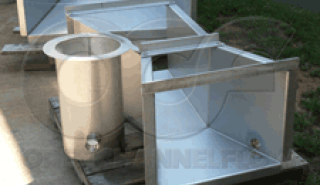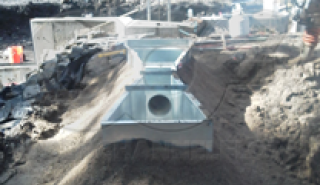 A hot spring is a natural upwelling of geothermally head groundwater. They can vary widely in temperature from those suitable for bathing to others so hot that immersion results in death or severe injury. Hot springs may contain high level of dissolved minerals (ranging from calcium to radium) and also thermophilic life.
A hot spring is a natural upwelling of geothermally head groundwater. They can vary widely in temperature from those suitable for bathing to others so hot that immersion results in death or severe injury. Hot springs may contain high level of dissolved minerals (ranging from calcium to radium) and also thermophilic life.
Measuring the flow out a hot spring is usually best done with a flume instead of a weir. The sensitivity of weirs to imperfections on the weir crest can result in installations that require frequent maintenance or which drift in accuracy over time.
In applications where the spring water is less than 100º F on average, standard fiberglass flumes are commonly used. They are lighter, cheaper, and somewhat easier to install than other flume made from other materials. However, most general purpose fiberglass resins have a peak operating temperature of 140º F. For sites where the sustained water temperature is above 120º F, stainless steel is almost exclusively used (although high temperature resins / gel coats are available for fiberglass flumes).
Where the flow from the hot springs is constant (or within a given band of flows), Parshall flumes are commonly used. Build-up on the sidewalls / floor of the flume is less critical than some other flume types (HS / H / HL and Trapezoidal) and most operators are familiar with the flume and how to measure flow with it.
If the spring discharge is free-spilling where it is measured a modified version of the Parshall flume can be used – the Montana (Short Parshall) flume. The Montana flume starts with the basic Parshall flume and removes the extended throat and discharge section. This results in a flume that is lighter in weight, shorter in length, and cheaper to construction than a full sized Parshall – yet which still uses the same discharge equations.
Where the upstream conditions are good, Cutthroat flume can also be used. These flumes come in a range of standard lengths and throat widths and are well suited for flat grade installations. They are also relatively easy to construct in stainless steel – should the application require it.
Hot springs where the flow range is fairly wide may require that a different flume be used than above. Here Trapezoidal flumes are more common. While scaling / grown on the flume can affect its discharge characteristics, the impact is not as great as it would be for a HS / H / HL flume. Also, as there is no rise in the flume (as there is in the similarly shaped RBC flume), solids collection is less likely.
Unless the flow is piped prior to measurement, Palmer-Bowlus flumes are not normally used to meausre hot spring discharges. Other flumes can generally hanldle the flows better and Palmer-Bowlus flumes are much more costly to construct in stainless steel than other flume types.
Image: Wikipedia





